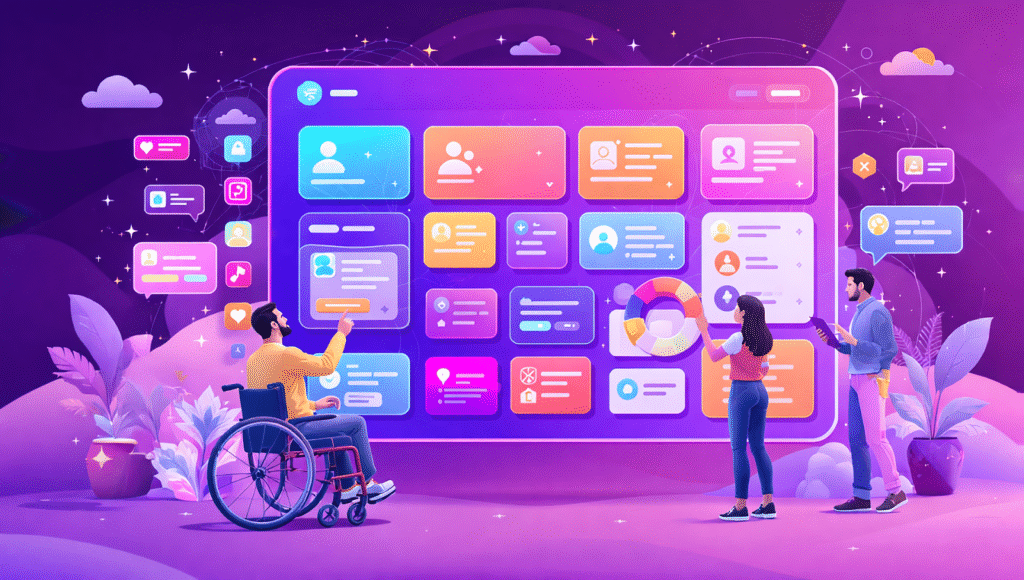Accessibility is no longer a “nice-to-have.” For millions of people with vision, hearing, motor, or cognitive differences, it’s the difference between being able to use a product — or being locked out of it. When we think about scaling accessibility across large organizations, design systems play a critical role. They act as the foundation for how teams design, build, and ship products.
This article explores what’s new in WCAG 2.2, how to embed accessibility into design systems, and the best practices companies can follow to make inclusive design scalable and sustainable.

What’s New in WCAG 2.2
The Web Content Accessibility Guidelines (WCAG) 2.2 build on WCAG 2.1 and introduce 9 new success criteria. These updates address real-world problems such as:
Focus appearance – making it easier for users to see where they are on a page.
Target size – ensuring buttons and interactive elements are big enough to use easily on touchscreens.
Dragging movements – providing alternatives for users who cannot drag and drop.
Accessible authentication – avoiding barriers such as solving puzzles or remembering complex passwords.
In short, WCAG 2.2 makes digital products more usable for people with mobility, vision, and cognitive challenges. For design systems, this means updating components to meet these requirements by default.
Why Design Systems Are the Key
A design system is more than just a style guide. It’s a library of reusable components, design tokens, and documentation that teams use to build consistent products. When accessibility is baked into these foundations, every product that adopts the system benefits automatically.
For example:
If your button component already meets color contrast requirements, every product using it inherits that compliance.
If your modal dialog manages focus correctly, every team benefits without reinventing the wheel.
This is why design systems are often called “force multipliers” for accessibility.
How to Build Accessibility into a Design System
Start with Design Tokens
Define accessible color palettes that meet WCAG contrast ratios.
Create spacing and sizing tokens to guarantee minimum touch target sizes.
Include focus tokens that make focus styles visible and consistent.
Make Components Accessible by Default
Buttons: semantic HTML (<button>), visible focus, and ARIA support.
Forms: proper labels, error messages linked to inputs, and accessible placeholders.
Modals: trap focus, provide aria-modal, and restore focus on close.
Navigation: fully keyboard operable with skip links.
Document Clearly
Each component should include:
Accessibility do’s and don’ts.
Example code snippets with best practices.
Notes about WCAG criteria covered.
Testing and Validation
Automated Testing
Tools like axe, Lighthouse, and WAVE can catch many common accessibility issues. Integrate them into your CI/CD pipeline so regressions are flagged early.
Manual Testing
Automation alone isn’t enough. Always test with:
Keyboard only – can every interaction be completed without a mouse?
Screen readers – is the content understandable with JAWS, NVDA, or VoiceOver?
Zoom & reflow – does the layout still work when text is enlarged?
User Testing
The most valuable insights come from real people with disabilities using your product. Their feedback highlights issues that tools can’t detect.
Governance and Ownership
Accessibility at scale requires clear ownership. A strong approach looks like this:
The design system team maintains accessible components.
Product teams are responsible for using them correctly.
Accessibility champions in each squad provide guidance.
Leaders and executives ensure accessibility remains a business priority.
Governance ensures accessibility isn’t treated as a one-time project, but as an ongoing responsibility.
Real-World Examples
IBM Carbon Design System – every component includes accessibility notes and is tested against assistive technologies.
Material Design – Google provides guidelines for touch targets, motion, and color accessibility.
GOV.UK Design System – widely regarded as a gold standard for public service accessibility, with strategy documents that make accessibility a default.
Common Pitfalls to Avoid
Only relying on automation – human testing is always needed.
Overriding accessible defaults – teams should avoid removing focus styles or changing semantic roles.
Treating accessibility as optional – accessibility should be non-negotiable, just like security or performance.
Conclusion
Inclusive design is about more than compliance — it’s about creating products that work for everyone.
By aligning design systems with WCAG 2.2 and beyond, organizations can:
Deliver better user experiences.
Reduce development rework.
Protect themselves legally.
Most importantly, include millions of people who are often excluded.
When accessibility is built into design systems, it scales. It becomes part of the culture, not an afterthought. And that’s how we move closer to a truly inclusive digital world.
Frequently Asked Questions (FAQs)
1. What is inclusive design at scale?
Inclusive design at scale means embedding accessibility into design systems so all digital products are usable by everyone. Brigita builds accessibility-first design systems aligned with WCAG 2.2, enabling consistent inclusive experiences for users worldwide, including India, USA, UAE, Dubai, and GCC regions.
2. How does Brigita support WCAG 2.2 compliance globally?
Brigita integrates WCAG 2.2 requirements directly into design tokens, components, and documentation, ensuring accessibility compliance and usability across enterprise platforms used in Worldwide markets, India, USA, UAE, Dubai, and GCC.
3. Why are design systems important for accessibility?
Design systems allow accessibility to be built once and reused everywhere. Brigita’s design systems ensure keyboard access, screen-reader support, proper contrast, and focus visibility, helping organizations maintain accessibility at scale across global regions.
4. What accessibility features should a modern design system include?
A modern design system should include WCAG-compliant color contrast, visible focus indicators, accessible forms, semantic components, keyboard navigation, and inclusive interaction patterns. Brigita delivers these features for enterprises worldwide, including India, USA, UAE, Dubai, and GCC.
5. How does Brigita test accessibility for international products?
Brigita combines automated tools with manual testing, including keyboard navigation, screen-reader validation, and usability checks. This ensures real-world accessibility for digital products used across Worldwide, India, USA, UAE, Dubai, and GCC markets.
Search
Categories

Author
-
Vijay is a UI/UX and Graphics Designer with over five years of experience in the design industry. Skilled in creating user-friendly apps, websites, and branding materials, he has successfully handled a variety of projects that balance creativity with functionality. His design approach focuses on delivering seamless user experiences while maintaining strong visual appeal. Known as a creative problem-solver, Vijay enjoys collaborating with teams and clients to bring ideas to life. Beyond work, he has a keen interest in cricket and chess, which fuel his passion for strategy, focus, and continuous growth.
